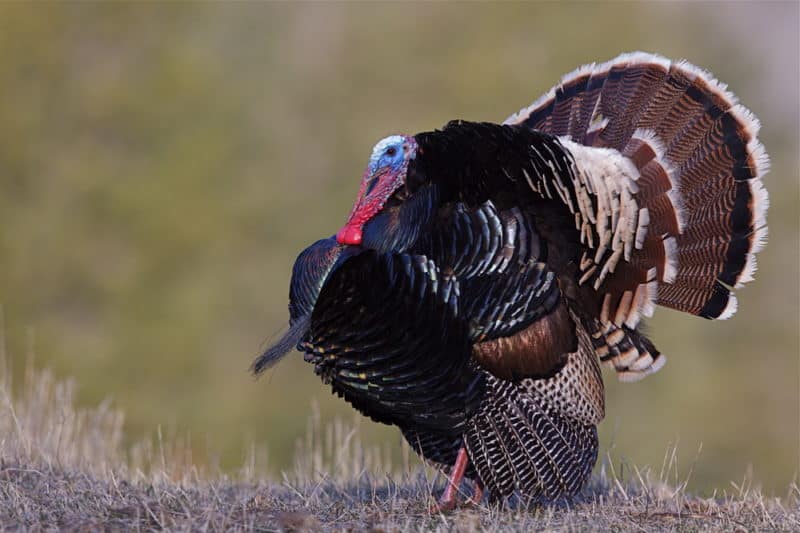The wild turkey (Meleagris gallopavo) is the largest of the upland game birds that are native to North America. They are similar in appearance to domestic turkeys, but they have longer legs and a more streamlined, slender body.
The turkey is thought to have been present in North America before the early European settlers arrived and may have even predated the first human inhabitants. At the time of European colonization, the wild turkey occupied much of the Eastern United States.
Wild turkeys were important food animals for Native Americans, but overhunting caused extinction throughout much of their range in the early 1900s. Today, modern wildlife management techniques have helped to reintroduce wild turkeys throughout their historic range.
Description
The adult male or (tom) weighs anywhere from 15 to 25 lbs. and is around 39-49 inches long. They have dark iridescent feathers in red, purple, green, copper, and bronze shades. Their flight feathers are black with brown stripes and white bars. They have a fleshy, bare head that, along with their neck, is brightly colored with red, white, and blue. The color changes with the turkey’s mood; when they are most excited, it is white. On their throat is a wattle which is a red fleshy lobe that hangs down, and a warty projection on the forehead called a caruncle. They also have a tuft of modified feathers on their chest called a beard. On the end of their long legs, they have spurs that measure from 1/2 to 1 1/2 inches long.
Females or (hens) weigh anywhere from 8 to 12 lbs and are around 36 inches long. Their feathers are not as flashy as the males; they are dark brown with even darker bars. Their head is a pale greyish-blue color, and their neck is feathered. 90% of the hens do not have beards, while 10% do.
The wild turkey mating and reproduction
Early Spring is the breeding season for wild turkeys, which starts in late March-early April. During this time, the adult males strut around to attract the willing hens. This strutting behavior includes the following, fluffing their feathers on their breasts and backs, fanning their tail feathers, dragging their wings, and gobbling. The tom turkeys gobble can be heard at a distance of a square mile. The tom will mate with several hens.
After mating, the hen will then go off by herself to build her shallow nest. Their nests are generally built in wooded areas but can also be in open fields and brushy areas. Nests are a shallow depression formed by scratching, squatting, and then laying eggs. The females will lay between 10 and 20 eggs and then incubate them for about 28 days. The young turkeys can fly within two to three weeks of age.
Range, Habitat, and Diet
The wild turkey is native to the forests and woodlands of North America. It is found in eastern and western regions of the continent, from Southern Canada to the Gulf of Mexico and northern California. The wild turkey lives in forested areas but can also be found in grasslands and shrublands. They prefer lowland areas with a lot of covers. Turkey’s habitats often consist of deciduous forests, which provide plenty of food.
The diet and habitat of the wild turkey are based on plants, berries, seeds, and insects. In spring, turkeys forage on leftover nuts, tender plant shoots, and grass. During summer, they feed on berries, seeds, and insects. Turkeys also feed on small reptiles and fruits. The winter months are filled with ice and snow cover, preventing the birds from foraging on the ground. Despite this, turkeys can survive by consuming evergreen ferns, buds, and stems of the sugar maple.
During summer, wild turkeys can be found in pastures or fields. In such cases, they compete with domestic animals for food. Large populations of deer and rodents may also deplete the normal diet of wild turkeys. On the other hand, when food supplies are plentiful, turkeys do not have competition from other animals. In addition to this, human activities can create unhealthy conditions for the birds. Besides, artificial feeding can overconcentrate the birds, making them more vulnerable to poaching and spreading disease.
Flocks and Territories
The wild turkey is a gregarious species and will large flocks of up to 50 birds. They will often fit into a very large territory, several square miles. The male turkey is the leader of the flock and will lead the females to feeding areas. The females will show their young to feeding grounds where they can find food and shelter. The males will lead and defend their territories while the female turkeys guard the young ones. They will also use different types of calls and sounds to communicate with one another. Flocks can be up to 100 birds in size, but they are usually smaller than this size.
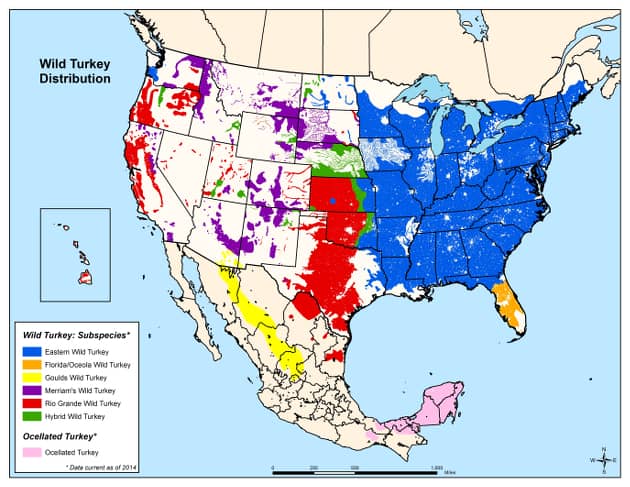
6 Distinct Subspecies of Wild Turkey
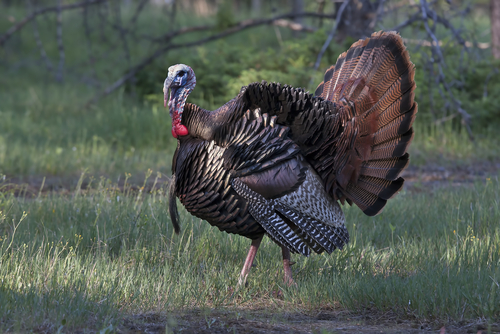
Eastern wild turkey
The eastern wild turkey is the first wild turkey subspecies that the early colonists first encountered. Their range is the largest of all subspecies, covering the eastern half of the United States, from northern Florida up to Maine and extending west to Minnesota, Illinois, and Missouri. Their Canadian range extends through Southeastern Manitoba, Ontario, Southwestern Quebec, and the Maritime Provinces.
- Tom’s weigh 18 -30 lbs.
- Hens weigh 8 -12 lbs.
- Tips of tail feathers are chestnut brown.
- Black and white bars on the wings
- Longest beards of the wild turkey subspecies
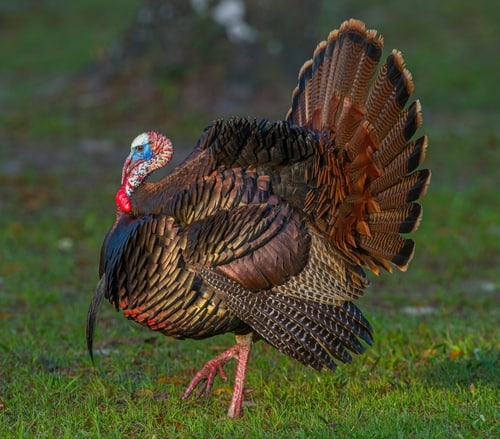
Osceola wild turkey
The Osceola turkey ranges across the peninsula of Central and South Florida. While their population doesn’t exceed 100,000, they have adapted to these conditions by hiding in swamps and roosting over water.
- Toms weigh around 20 lbs.
- Hens weigh 8 to 20 lbs.
- Tips of tail feathers are dark brown
- Small white bands on black wings
- Beard length is just shorter than the Eastern
- Long spurs
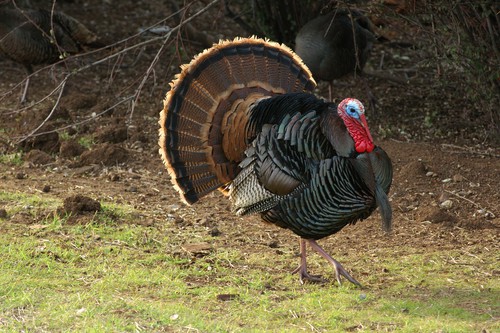
Rio Grande turkey
Texas is the top state for Rio Grande turkeys, with an estimated 600,000 birds. Kansas, Oklahoma, Nebraska, Oregon, California, Idaho, South Dakota, Utah, Colorado, Wyoming, and New Mexico also have large Rio Grande turkey populations. They were also introduced to Hawaii in the late 1950s.
- Toms weigh around 20 lbs.
- Hens weigh 8 – 12 lbs.
- Tips of tail feathers are tan.
- Equal black and white barring on wings.
- Moderate beard length
- Moderate spurs
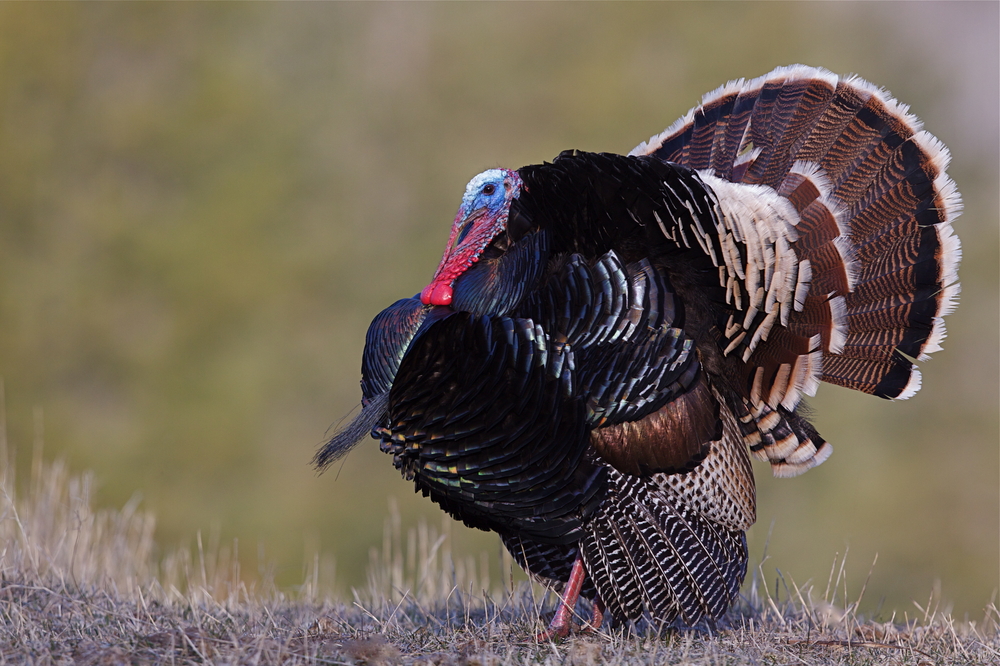
Merriam’s wild turkey
The Merriam’s turkey can be found throughout the Rocky Mountains and the meadowlands of South Dakota, Montana, Utah, Wyoming, Arizona, and New Mexico.
- Toms weigh 18 – 30 lbs.
- Hens weigh 8 – 12 lbs.
- Tips of tail feathers are white.
- Wings have more white and less black.
- Shortest beards of the wild turkey subspecies.
- Shortest spurs.
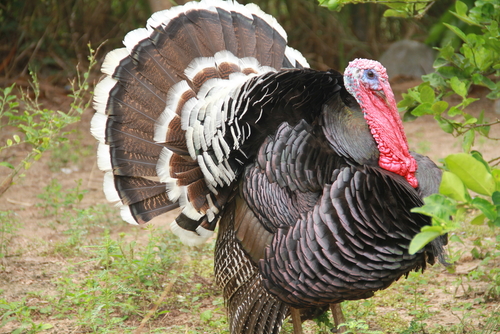
Gould’s wild turkey
Gould’s wild turkeys are native to southern Arizona and New Mexico to the northern mountains of Mexico.
- Toms weigh 18 – 30 lbs.
- Hens weigh 8 – 12 lbs.
- Tips of tail feathers are off-white.
- Wings are moderately colored.
- Moderate beard length.
- Moderate spur length.
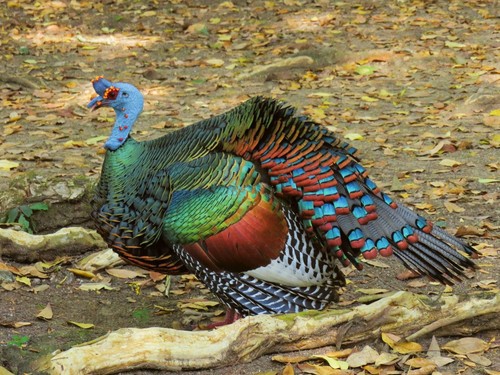
Ocellated turkey
The Ocellated turkey is the only wild turkey subspecies not found in the United States or Canada, they are only found in Mexico.
- Toms weigh 11 – 12 lbs.
- Hens weigh 6 – 7 lbs.
- Lustrous prismatic body feathers.
- Tail feathers are gray with gold and blue tips.
- The wings are black and white.
- No beard.
- Very long spurs.
Wild Turkey Conservation Efforts
Throughout the years, the wild turkey population has declined due to overhunting and habitat loss. While European colonists viewed wildlife as an endless resource, modern conservationists have rallied to stop their decline and protect their habitats by creating protected areas and passing game laws. Today, they are the backbone of the National Wild Turkey Conservation movement. The mission of the National Wild Turkey Federation is to protect and preserve the wild turkey and the hunting heritage that it represents. There are more than 250,000 members in 14 countries.
Recent Posts
The only venomous snakes in Washington State are Northern Pacific Rattlesnakes. The Northern Pacific Rattlesnake (Crotalus oreganus oreganus) is a sub-species of the Western Rattlesnake. Anyone...
Skunks are not classified as true hibernators. But they go into a state of torpor when the weather gets cold. Skunks are light sleep hibernators, along with opossums, bears, and raccoons. ...

